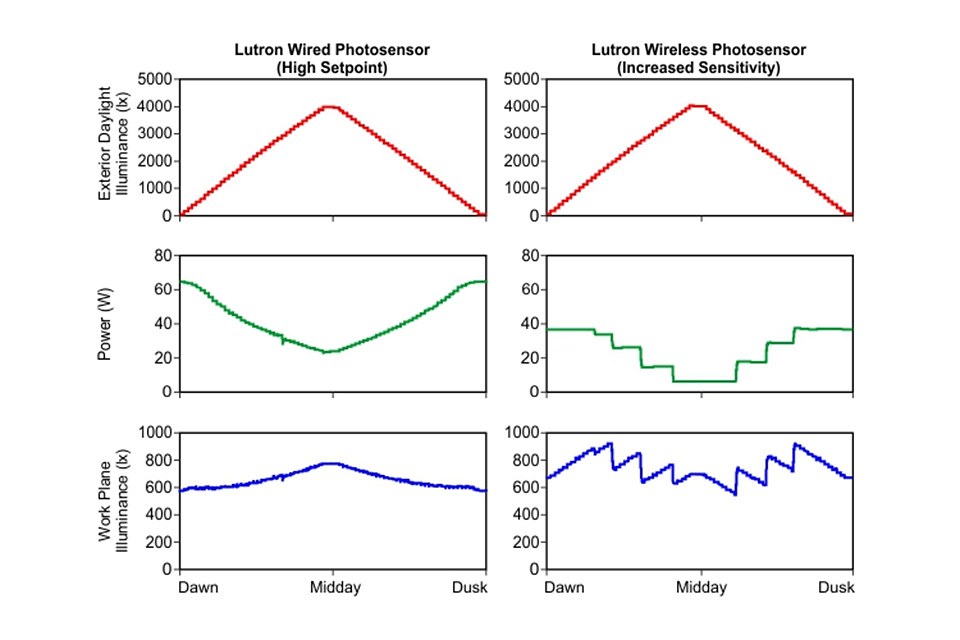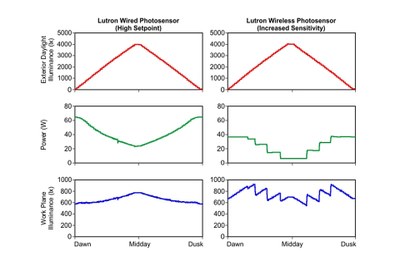NLPIP Releases Report on Wired and Wireless Lighting Controls
The National Lighting Product Information Program (NLPIP) at Rensselaer Polytechnic Institute’s Lighting Research Center (LRC) recently released its latest publication, Lighting Answers: Comparison of Wired and Wireless Lighting Controls for Single Rooms.
The report details findings from NLPIP’s study of wireless occupancy sensors and photosensors, focusing on control systems designed for a single room in a commercial building such as an office, classroom, or conference room. The investigation included occupancy sensor and photosensor features and performance, wireless communication performance, compatibility with lighting products, energy harvesting and storage capabilities, and capital costs of control systems.
Abstract:
The National Lighting Product Information Program (NLPIP) investigated the performance of wireless occupancy sensors and photosensors, focusing on control systems designed for a single room in a commercial building such as an office, classroom, or conference room. NLPIP tested wireless and wired control systems from Lutron, Leviton, and WattStopper because these are the brands of controls most frequently selected by specifiers according to an NLPIP survey.
The investigation included:
• Occupancy sensor and photosensor features and performance
• Wireless communication performance
• Compatibility with lighting products
• Energy harvesting and storage capabilities
• Capital costs of control systems
Key findings include:
• Wireless occupancy sensors from the evaluated brands were available with only passive infrared detection technology. The lack of wireless ultrasonic and dual technology occupancy detectors should be taken into consideration where furniture may block motion detection.
• The wireless occupancy sensors and photosensors tested had similar performance as equivalent wired sensors from the same manufacturer.
• The wireless communication was robust in a typical office environment.
• For controllers that don’t make use of a neutral wire and/or are installed in a switchbox without a neutral wire, operation could be an issue for lighting with electronic ballasts or drivers, so verification is needed.
• Photovoltaic energy harvesting by the tested occupancy sensors is likely to be insufficient at some ceiling locations. Installing a battery in the sensor will circumvent this problem.
• The tested wireless occupancy sensor systems had 54 to 128% higher capital costs than the equivalent wired systems from the same brand.
The report was sponsored by the Connecticut Energy Efficiency Fund and Natural Resources Canada.
Lighting Answers: Comparison of Wired and Wireless Lighting Controls for Single Rooms is available free to the public, courtesy of the above sponsors, at: http://www.lrc.rpi.edu/nlpip/publicationDetails.asp?id=944&type=2.
You may download a PDF copy or you can read the report online.
About NLPIP:
NLPIP, the National Lighting Product Information Program, helps lighting professionals, contractors, designers, building managers, homeowners, and other consumers find and effectively use efficient, quality products that meet their lighting needs. With the support of government agencies, public benefit organizations, and electric utilities, NLPIP disseminates objective, accurate, timely, manufacturer-specific information about energy-efficient lighting products. Established by the Lighting Research Center in 1990, NLPIP team members are LRC researchers—leading experts in efficient lighting, human factors and technology transfer. The NLPIP product testing laboratory is a non-manufacturer, NVLAP-accredited lab (NVLAP lab code: 200480-0). NLPIP's research and product testing has included many products such as compact fluorescent lamps (CFLs), T5 fluorescent systems, metal halide lamps, dimming ballasts, and occupancy sensors, as well as timely subjects such as light pollution, full-spectrum light sources, and light sources and color.
About the Lighting Research Center:
The Lighting Research Center (LRC) at Rensselaer Polytechnic Institute is the world's leading center for lighting research and education. Established in 1988 by the New York State Energy Research and Development Authority (NYSERDA), the LRC has been pioneering research in energy and the environment, light and health, transportation lighting and safety, and solid-state lighting for more than 25 years.
In 1990, the LRC became the first university research center to offer graduate degrees in lighting and today the LRC offers both a M.S. in lighting as well as a Ph.D. to educate future leaders in lighting. Internationally recognized as the preeminent source for objective information on all aspects of lighting technology and application, LRC researchers conduct independent, third-party testing of lighting products in the LRC's state of the art photometric laboratories, the only university lighting laboratories accredited by the National Voluntary Laboratory Accreditation Program (NVLAP Lab Code: 200480-0). LRC researchers are continuously working to develop new and better ways to measure the value of light and lighting systems, such as the effect of light on human health, and the effect of light on plant physiology.
The LRC believes that by accurately matching the lighting technology and application to the needs of the end user, it is possible to design lighting that benefits both society and the environment.
About Rensselaer Polytechnic Institute:
Rensselaer Polytechnic Institute, founded in 1824, is the nation's oldest technological university. The university offers bachelor's, master's, and doctoral degrees in engineering, the sciences, information technology, architecture, management, and the humanities and social sciences. Institute programs serve undergraduates, graduate students, and working professionals around the world. Rensselaer faculty are known for pre-eminence in research conducted in a wide range of fields, with particular emphasis in biotechnology, nanotechnology, information technology, and the media arts and technology. The Institute is well known for its success in the transfer of technology from the laboratory to the marketplace so that new discoveries and inventions benefit human life, protect the environment, and strengthen economic development.


